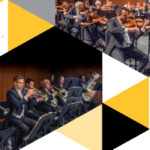Program Notes, ©2013 Lori Newman
Program Notes
Aaron Copland Appalachian Spring
(Orchestral Suite from the Ballet) (1944)
(Born 1900, Brooklyn, New York; died 1990, Tarrytown, New York)
Aaron Copland’s Appalachian Spring began as a ballet commissioned by the Elizabeth Sprague Coolidge Foundation. The eponymous foundation was a collaboration with the Library of Congress, and their intention was to promote the composition and performance of modern chamber music. Elizabeth Coolidge stated, “My plea for modern music is not that we should like it, nor necessarily that we should even understand it, but that we should exhibit it as a significant human document.” If you were to list all of the influential 20th century composers you could think of, you would find that most of those on your list have works commissioned by the E.S.P. Foundation.
Appalachian Spring afforded two titans of the mid-century American fine arts scene a chance to collaborate – Copland, and the ground-breaking modern dancer and choreographer, Martha Graham. Copland and Graham had developed a friendship a decade earlier, but this was the first opportunity for them to fuse their collective genius. Martha Graham choreographed the ballet, as well as danced the lead role in the work’s premiere on October 30, 1944. Since this was a chamber music series, the Coolidge Auditorium at the Library of Congress was quite small; thus, the original music for the ballet was not for full orchestra, but a complement of merely thirteen instruments. The orchestral version was arranged by Copland soon after the ballet’s premiere and first performed in 1945 by the New York Philharmonic.
The ballet used the working title of Ballet for Martha (this still remains as the ballet’s subtitle) during most of its composition, but soon before the premiere Martha Graham settled on Appalachian Spring, a phrase she had found in a poem by American author, Hart Crane. Copland and Graham fully admitted that the title had no relationship to the story that the ballet told, and the phrase from the poem referred not to the season, but to a water source. Copland wrote this synopsis of the ballet’s story:
A pioneer celebration in spring around a newly built farmhouse in the Pennsylvania hills in the early part of the last [19th] century. The bride-to-be and the young farmer-husband enact the emotions, joyful and apprehensive, which their new domestic partnership invites. An older neighbor suggests now and then the rocky confidence of experience. A revivalist [preacher] and his followers remind the new householders of the strange and terrible aspects of human fate. At the end the couple are left quiet and strong in their new house.
Appalachian Spring is Copland’s third ballet from his Americana period, the others being Billy the Kid and Rodeo. It contains his trademark American style, and its most famous section, the variations on the Shaker folk tune “Simple Gifts.” Copland conceded this inclusion was less than historically accurate, as there had never been a Shaker settlement in Pennsylvania.
Claude Debussy Prélude à l’après-midi d’un faune (1892 – 1894)
(Born 1862, St. Germaine-en-Laye, France; died 1918, Paris, France)
Claude Debussy based his Prélude à l’après-midi d’un faune on the poem of the same name by the French symbolist composer, Stéphane Mallarmé. The poem chronicles a faun or satyr, a mythical half-goat, half-man creature who lives a rather hedonistic life in the forest. He is daydreaming, or perhaps half asleep, as he conjures images about woodland nymphs that he tries to embrace, but the images and nymphs are ever fleeting. The faun plays a panpipe, or syrinx, during his woodland reverie, and the flute (the closest orchestral instrument equivalent) is featured prominently throughout the work.
Debussy was one of the Impressionist composers that burst onto the scene in the late 19th century. The dreamlike aspects of Mallarmé’s poem were the perfect fodder for Debussy as an Impressionist composer. Impressionist music, like Impressionist art (think Monet’s Water Lilies), blurs the lines of demarcation in their respective fields. In art, lines and contours are blurred, while in music, it is rhythm and tonality which are nebulous.
One of the most famous flute solos in all of music is contained in the first four measures of Prélude à l’après-midi d’un faune. The opening solo is completely unaccompanied, and is often not conducted; the solo returns several times with different accompaniments and is one of the unifying elements of Debussy’s Prelude. It opens on a C#, a note which is generally lacking in color and depth on the flute; Debussy chose the perfect note to begin his Impressionistic dream-like tale. The solo then descends in a mostly chromatic pattern to a G, the two highlighted notes (C# and G) equaling the interval of a tritone – a very chromatic and dissonant interval. The freeness of the flute solo and the music that follows sounds completely irregular and unstructured, but upon further analysis, one can see that Debussy’s work is anything but these things. The entire work is spun from that opening flute solo and is completely structured, but to the listener, the harmonies seem unfulfilling, and the rhythms seem amorphous. Debussy uses great ranges of color and orchestration in his Faun. While written for a relatively small complement of instruments, he writes the wind parts in interesting and unlikely ranges, and his use of two harps adds to the fantasy aspect of Mallarmé’s poem.
Igor Stravinsky The Rite of Spring (Le Sacre du printemps) (1911 – 1913)
(Born 1882, Oranienbaum, near St. Petersburg, Russia; died 1971, New York City)
May 29, 1913, is classical music’s equivalent of the “date that will live in infamy.” On this date, Stravinsky’s ballet The Rite of Spring premiered in Paris’s Théâtre des Champs-Elysées, and many mark this date as the true inauguration of 20th century music. The main players in this ground-breaking production were Serge Diaghilev and the famed Ballet Russes, producer; Vaslav Nijinsky, choreography; Nicholas Roerich, designs and costumes; Pierre Monteux, conductor; and of course, Igor Stravinsky, composer.
The riot that ensued at the work’s premiere is a widely chronicled event with many eye witnesses to the chaos of the evening. It is indeed true that a riot broke out on opening night, but what is most misunderstood about this event is that the riot had little, or anything, to do with Stravinsky’s score. It was the dancing that got the audience in an uproar, with its primitive, common, and low to the ground choreography. This was not the Nutcracker and the audience wasn’t quite ready for the dancing which went along with the subject matter of a sacrificial rite. The music was almost completely drowned out by the shouting; fistfights erupted in the audience; there are tales of Nijinsky calling out numbers for the dancers so they could follow the choreography since the music was inaudible over the din of the rioting audience; and Diaghilev resorted to flipping the house lights on and off to try and restore order. Pierre Monteux, completely unfazed by the commotion, continued conducting as if nothing were wrong. Stravinsky was furious and stormed out, slamming the door behind him. He said of the event, “I have never again been that angry. The music was so familiar to me; I loved it, and I could not understand why people who had not yet heard it wanted to protest in advance.”
The Rite of Spring was the third Stravinsky/Diaghilev collaboration, behind The Firebird of 1910 and Petrushka of 1911. All three of Stravinsky’s famous ballets were written during what historians refer to as his “Russian” period, and The Rite of Spring is an imagined fertility ritual from pre-historic Russia. The image came to Stravinsky in a daydream about which he had said, “I saw in my imagination a solemn pagan rite: wise elders, seated in a circle, watching a young girl dance herself to death. They were sacrificing her to propitiate the god of spring.” The work is divided into two main sections, played without pause: I. The Adoration of the Earth, and II. The Sacrifice. Each part is further segmented into sections that help to depict the story. It is scored for a massive orchestra, employing most of the available wind auxiliary instruments, a large complement of strings and brass, and an expansive percussion section.
Stravinsky’s main innovations in The Rite of Spring are rhythmic in nature. He strives to blur the lines of rhythmic pulse, which is obvious in the work’s most famous section, the “Augurs of Spring,” where the accents are so displaced that it is hard to decipher in what meter the music is written. Other Stravinsky trademarks are dissonances based on Russian scales, such as the octatonic scale, and some polytonality; layering, as in stacking two or more independent pieces of music on top of one another; use, and some would say abuse, of ostinati, which are repeated patterns that form a sense of consistency, but in Stravinsky’s hands, begin consistently and then are mutated; and sound blocking, which is a technique of creating sound blocks to offer unity, as opposed to melodic repetition and development.
The riot of the premiere of The Rite of Spring was long forgotten when a year later the music was performed without the ballet and was so well received, that Stravinsky was carried from the concert hall on the shoulders of his supporters.



